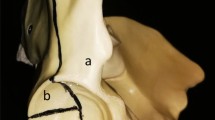Abstact
Background
Screw penetration of the hip joint is a serious complication during plate–screw internal fixation of acetabular anterior column or anterior wall fractures through an anterior approach. The purpose of the cadaveric study is to determine safe paths for screw placement on the anterior column of the acetabulum.
Methods
A total of 46 hemipelvises (24 male, 22 female) were utilized in this study. These hemipelvises were sectioned, and formed cross-sections anterior endpoint (AEP), anterior quarter point (AQP), midpoint (MP), posterior quarter point (PQP) and posterior endpoint (PEP), respectively. Positions at distances of 0.5-, 1.0-, and 1.5-cm lateral to the pelvic brim on cross-section AQP, MP and PQP were marked, respectively. The nearest distance from entry points of the anterior column to the hip joint, the average medial angulation of cortical screws at 0.5-, 1.0-, and 1.5-cm entry points on cross-section AQP, MP and PQP were measured.
Results
The nearest distance from 0.5-, 1.0-, and 1.5-cm entry points to the hip joint is 15.6 ± 1.5, 13.1 ± 1.2, and 11.2 ± 1.4 mm, respectively. The maximum medial angulation to provide safe cortical screw placement at 0.5-, 1.0-, and 1.5-cm entry points is 8.2 ± 2.2°, 14.9 ± 3.4°, and 26.1 ± 4.5°, respectively.
Conclusions
During the operation of plate–screw fixation of the anterior column on the acetabulum, there are three ways to avoid screw penetration of the hip joint. The first one is to use the long screw. Its entry point is placed as close to pelvic brim as possible, and the entry direction is parallel to the quadrilateral surface. The second one is to use the short screws whose lengths are 14, 12 and 10 mm and locate them in the region between the pelvis brim and 0.5-cm entry point, between 0.5- and 1.0-cm entry point, between 1.0- and 1.5-cm entry point, respectively, regardless of the direction of the screw placement. The third one is to take quadrilateral surface as a reference plane, and adjust the medial angulation of the screw placement according to different target locations, i.e., in the coronal plane ranges from 0° to 10° in the region between pelvis brim and 0.5-cm entry point, 10°–20° in the region between 0.5- and 1.0-cm entry point, and 20°–30° in the region between 1.0- and 1.5-cm entry point.







Similar content being viewed by others
References
Routt ML Jr, Swiontkowski MF (1990) Operative treatment of complex acetabular fractures: combined anterior and posterior exposures during the same procedure. J Bone Joint Surg Am 72:897–904
Oransky M, Sanguinetti C (1993) Surgical treatment of displaced acetabular fractures: results of 50 consecutive cases. J Orthop Trauma 7:28–32
Schopfer A, Willett K, Powell J et al (1993) Cerclage wiring in internal fixation of acetabular fractures. J Orthop Trauma 7:236–241
Letournel E (1993) The treatment of acetabular fractures through the ilioinguinal approach. Clin Orthop 292:62–76
Ebraheim NA, Savolaine ER, Hoeflinger MJ et al (1989) Radiological diagnosis of screw penetration of the hip joint in acetabular fracture reconstruction. J Orthop Trauma 3:196–201
Ebrahiem NA, Waldrop J, Yeasting RA et al (1992) Danger zone of the acetabulum. J Orthop Trauma 6:146–151
Anglen JO, DiPasquale T (1994) The reliability of detecting screw penetration of the acetabulum by intraoperative auscultation. J Orthop Trauma 8:404–408
Benedetti JA, Ebraheim NA, Xu RM et al (1996) Anatomic considerations of plate–screw fixation of the anterior column of the acetabulum. J Orthop Trauma 10:264–272
Shiramizu K, Naito M, Yatsunami M et al (2003) Quantitative anatomic characterisation of the pelvic brim to facilitate internal fixation through an anterior approach. J Orthop Surg (Hong Kong) 11:137–140
Acknowledgments
This work was supported by Grants from the Chinese Postdoctoral Science Foundation funded Project (ID: 20070421096), Shandong Provincial Science and Technology Development Plan Project (ID: 2007GG20002032) and Shandong Provincial Outstanding young and middle-aged Scientist Scientific Research Rewards Fund Project (ID: 2006BS03059). Our heartfelt thanks must go to Professor Xing Ziying (Department of Anatomy, Medical School of Shandong University, China), who has provided us with an insight for our research, some specimens and technical guidance, and others who are always available in offering us help in the research.
Author information
Authors and Affiliations
Corresponding author
Rights and permissions
About this article
Cite this article
Xian-quan, W., Jin-fang, C., Xue-cheng, C. et al. A quantitative anatomic study of plate–screw fixation of the acetabular anterior column through an anterior approach. Arch Orthop Trauma Surg 130, 257–262 (2010). https://doi.org/10.1007/s00402-009-0960-3
Received:
Published:
Issue Date:
DOI: https://doi.org/10.1007/s00402-009-0960-3




